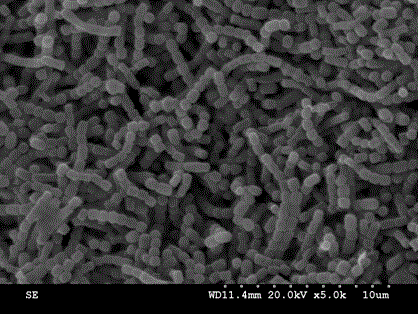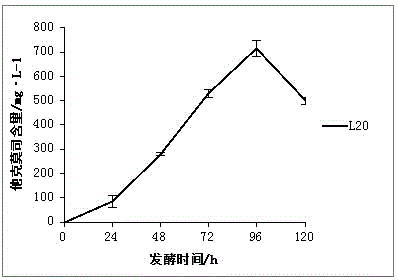Gene engineering strain streptomyces tsukubaensis L20 and application thereof
A technology of genetically engineered strains, Streptomyces tsukuba, applied in the field of bioengineering, can solve the problem of low fermentation units of strains, and achieve the effects of stable fermentation units, cost reduction, and stable genetic traits
- Summary
- Abstract
- Description
- Claims
- Application Information
AI Technical Summary
Problems solved by technology
Method used
Image
Examples
Embodiment 1
[0024] The acquisition of embodiment 1 Streptomyces tsukuba L20
[0025] The DNA sequence of SEQIDNO1 was amplified by polymerase chain reaction (PCR), and the amplified DNA fragments were digested by DNA restriction endonuclease and inserted into plasmid pIJ8660 respectively, and then the plasmid containing the above DNA sequence was transformed into the large intestine Bacillus ET12567 (which already contains plasmid pUZ8002).
[0026] Inoculate Escherichia coli ET12567 (already containing plasmid pUZ8002) containing the above plasmids into 40ml LB liquid medium (containing corresponding antibiotics) and culture at 37°C until OD 600 0.6, collect the bacteria by centrifugation, wash once with 10ml LB liquid medium, and resuspend with 0.5ml 2×YT liquid medium; add 20 μl of the screened Streptomyces tsukuba spores into 0.5ml 2×YT liquid medium Resuspend, heat shock at 45°C for 10 minutes, then cool in an ice bath for 2 minutes; mix the spores of the above-mentioned Escherichia...
Embodiment 2
[0027] The thalline morphology characteristic of embodiment 2 Streptomyces tsukuba L20
[0028] Streptomyces tsukuba L20 was cultured on ISP4 solid medium for 7 days, the hyphae and aerial hyphae in the base were well developed, the spore filaments were flexible or curved, the number of mature spore chain spores was more than 10, and the spores were short rods (see figure 1 ). The apparent characteristics in ISP4 solid medium, the results are shown in Table 1.
[0029]
Embodiment 3
[0030] The fermentation verification of embodiment 3 Streptomyces tsukuba L20
[0031] Inoculate 20 μl of Streptomyces tsukuba L20 spores into the seed medium at 250 rpm and incubate at 28°C for 24 hours; inoculate the mycelium in the seed medium at 10% inoculum into the fermentation medium at 250 rpm at 28°C After culturing for 120 hours, samples were taken after culturing for 24, 48, 72, 96 and 120 hours to measure the production of tacrolimus.
PUM
 Login to View More
Login to View More Abstract
Description
Claims
Application Information
 Login to View More
Login to View More - R&D
- Intellectual Property
- Life Sciences
- Materials
- Tech Scout
- Unparalleled Data Quality
- Higher Quality Content
- 60% Fewer Hallucinations
Browse by: Latest US Patents, China's latest patents, Technical Efficacy Thesaurus, Application Domain, Technology Topic, Popular Technical Reports.
© 2025 PatSnap. All rights reserved.Legal|Privacy policy|Modern Slavery Act Transparency Statement|Sitemap|About US| Contact US: help@patsnap.com



